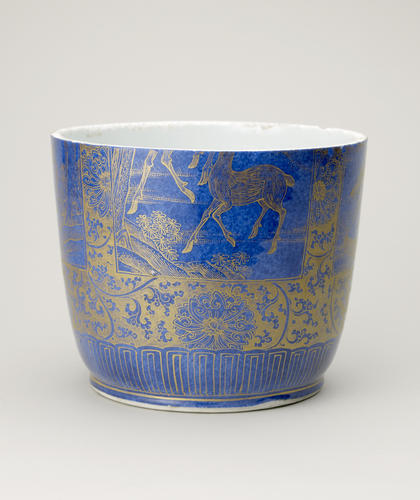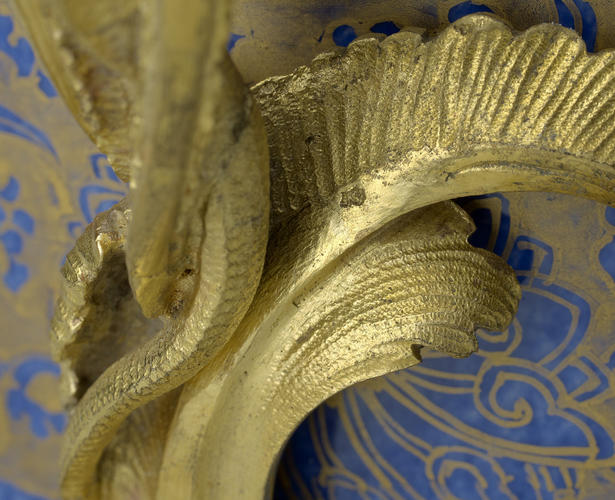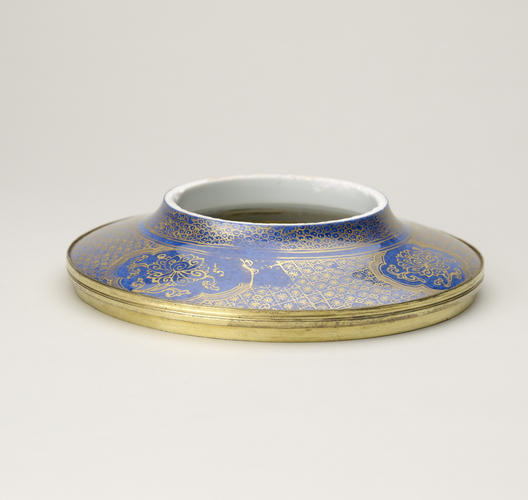Pair of jars and covers with mounts porcelain: 1700-20, mounts: 1725-50
Porcelain with powder-blue glaze overpainted in gilt and gilt bronze | 27.5 x 30.0 x 20.5 cm (whole object) | RCIN 35308






-
A pair of Chinese porcelain cut-down vases fitted with French gilt-bronze mounts. The lower parts of two cut-down rouleau vases, the covers made from the shoulders of the vases. With tapering sides rounded below, broad foot, and plain-glazed base painted with a double ring in blue. The mottled glaze is overpainted in gilt, with lotus scrolls inset with rectangular panels on both sides with a landscape with deer among rocks, and a petal border at the foot; on the cover, a band of four cartouches with lotus sprays on a diapered ground. The covers are surmounted with a domed roundel in gilt bronze, with radiating gadroon moulding divided by husk trails, with a berried acanthus cresting. The edge of the cover with a plain edge in gilt bronze, the top edge of the vase body cast with rockwork, flowers and foliage. On either side is a pair of boldly modelled handles in the form of dragons attached to the rim by hinges. The foot is set into a plain moulded circular mount enlivened by flowers and foliage.
A mark on the lower part of the handle on RCIN 35308.1 appears to resemble a small ‘C’ couronné poinçon.The ‘C’ couronné poinçon (crowned ‘C’ Stamp) was a tax mark applied to all traded metal objects containing copper. It was in effect between 1745 and 1749.
The jars are perhaps associated with a series of purchases from R. Owen, 95 New Bond Street, 25 July 1829: ‘Pr. blue Oriental Vases, mounted in Ormolu, dragon handles [£]26”5”-’ (RA GEO/MAIN/32767). The mounts are similar in style to other early mounted vases in the Collection, notably RCIN 100266 and RCIN 100989.
Favoured at the Qing court (1644–1911) on account of their Ming imperial connotations, glazes in deep cobalt blue were also a popular item of export throughout the period. There are many examples in the Collection of the mottled ‘powder blue’ of the Kangxi reign (1662–1722), with typical overpainted designs in gilt; and gilt-bronze candelabra of this colour were a requirement for the Green Drawing Room (later known as the Banqueting Room Gallery) at Brighton. A group of rarer pieces are those with pale blue glazes, among which are a number painted with designs in blue and red, which in France were often dressed in gilt-bronze mounts of the highest quality.Text adapted from Chinese and Japanese Works of Art in the Collection of Her Majesty The Queen: Volume II.
Provenance
Probably George IV, 1829. Inventoried at the Royal Pavilion, Brighton (1829B, p. 109), and in 1847 sent to Buckingham Palace (1829A, p. 14). Later listed in the ‘1866’ Windsor Castle Inventory, pp. 416–17, no. 747, in the Van Dyck Room (now known as the Queen’s Ballroom) and Presence Chamber.
-
Creator(s)
(metalworker)(nationality)Acquirer(s)
-
Medium and techniques
Porcelain with powder-blue glaze overpainted in gilt and gilt bronze
Measurements
27.5 x 30.0 x 20.5 cm (whole object)
Category
Object type(s)
Other number(s)







